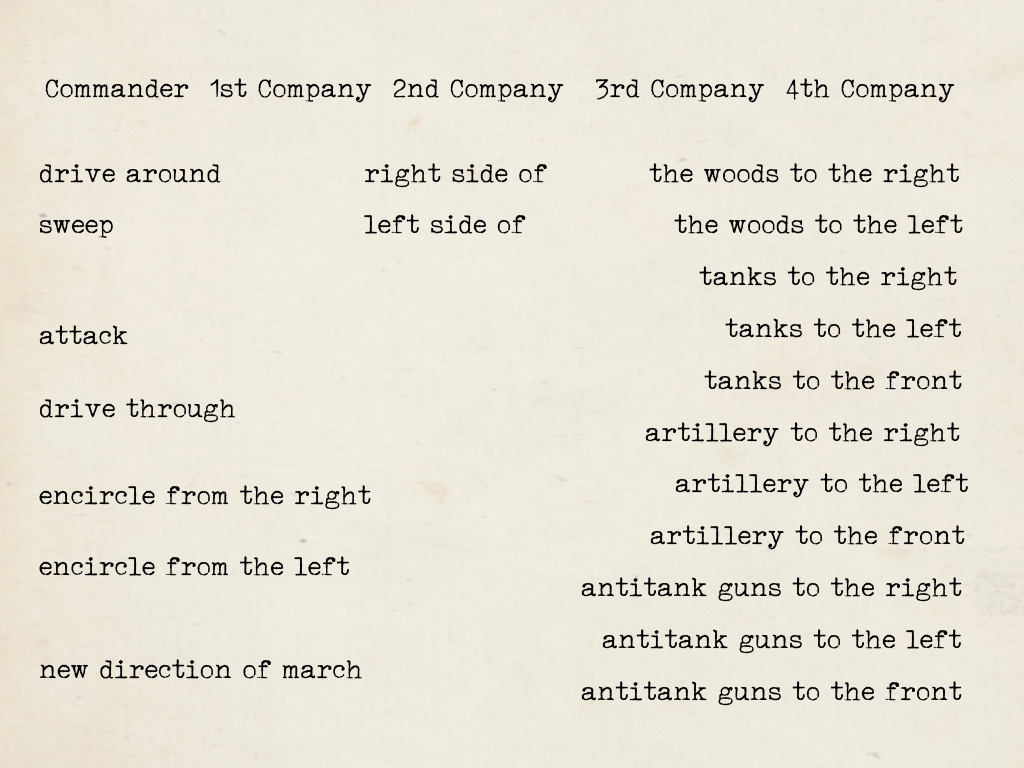“Leading a Tank Battalion During Systematic Radio Jamming (From the After-Action Report of a Tank Battalion)”, from the Nachrichtenblatt der Panzertruppen, Number 8, February, 1944.
During periods of enemy air superiority there is a possibility that the enemy will jam some wave lengths, possibly (though this has yet to happen!), the entire wave-band. Because of this we must take measures to maintain command and control of a tank battalion despite the systematic jamming of radio communications.
I. The following lessons are provided by battalion exercises aimed at leading a tank battalion during systematic radio jamming.
a. If the enemy jams only one wavelength, the alternative or reserve frequencies provide for in the frequencies list are to be used without further orders.
b. If the enemy jams the entire waveband, the unit leader makes use of the following means of command.
(1) Command by personal example.
(2) Indication of the direction of march by hand and arm signals. This can also be used for designating formations.
(3) Handing out written orders that are passed by means of a pole from the battalion commander’s tank to “messenger tanks” (from the Reconnaissance Platoon) and from there to the company commanders. For this purpose, a preprinted form on the following model [see example below] was used. The commands to be given are underlined in colored pencil.
(4) Use of signal flares, signal cartridges, and hand-held smoke grenades according to a strictly established plan which must be understood by the entire battalion.
(5) Along roads, railroad lines, parallel to bridges or rivers: lead [the unit] from landmark to landmark.
(6) Lead by means of an orders group that discusses the smallest details and includes all crew members.
II. The battalion which carried out exercises using these techniques came to the following conclusions:
a. Leading by personal example is the best and most secure.
b. Giving out written orders by means of “messenger tanks ” re- quires a great deal of time.
c. In battle, commands issued by means of light signals, signal cartridges, and hand-held smoke did not attract sufficient attention.
d. In leading along roads, railroads, etc. giving commands at certain intervals is useful. That is to say, a unit should march one to one and a half kilometers, in favorable terrain no more than three kilometers. Then it should be gathered for written or verbal orders before a further march or an attack.
e. Giving super-detailed orders costs a great deal of time and loses its value once the firing starts.
III. The Inspector General of Armored Troops Adds the Following Comments
a. In order to combat systematic jamming, measures must be taken to ensure liaison with company commanders.
b. The company commanders must be able to lead using the techniques described above in paragraph I b.
c. Above all, the following are important:
(1) Leading by personal example.
(2) Designating the direction of march by means of signal flags and pennants.
(3) Keeping to a minimum the use of hand-held smoke grenades, light signals, and signal cartridges.
(4) Moving the company from overwatch position to overwatch position.
(5) Leading after the issuance of a clear order which keeps each member of the company “read into the situation. ” Then the measures described in paragraphs 2) to 4) will only be required on occasion and every crew member will know what the company commander expects of him.
d. Objections
(1) Indicating march and fighting formations by means of hand and arm signals. This requires that the tank commander expose his upper body and thus makes himself a “prize target ” for every enemy round.
(2) Issuing written orders and distributing them by means of “messenger tanks.” Reason: It takes too much time. Tank attacks depend on the maintenance of momentum.
(3) Moving along roads, paths, railroads, etc. Reason: Historically, such places are the most dangerous for a tank attack because of obstacles, mines, massed anti-tank guns etc.
(4) Moving parallel to creeks and rivers. Reason: Too many bogs; many cross streams, which are difficult to get around; danger of mines. Attacks with an open flank on a river are not feasible tactically.
e. All methods of commanding a tank company are primitive and meet the requirements of armored troops only to a limited degree. Only by means of intensive training (like drill!) can a unit be brought to a point where these command problems can be overcome.







